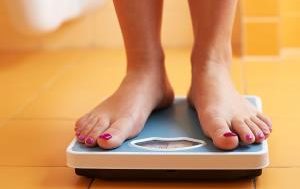There’s no reason you can’t look as fit and fabulous at 50 as you did at 40.
But there is one hitch: Even stars with personal trainers and nutrition coaches have to work a little harder to lose the pounds once they hit this milestone age.
One of the main reasons you’ll have to put in extra effort: Your body composition changes as you age. You lose muscle mass at an average rate of 3-5% for every 10 years after age 35, and this can impact the way you burn fat. “Your body goes into its aging stage as it leaves the growing one,” says Dr. Luiza Petre, a New York City-based weight loss and management specialist, and assistant clinical professor of cardiology at the Mount Sinai School of Medicine. “When this happens, your body doesn’t need as much energy as it used to,” she explains.
Why it’s harder to lose weight after 50
What’s more, all those years of playing sports, running after your kids and walking up and down stairs take their toll. You may notice that your joints are a little stiffer and your muscles are a little sorer than they were a few decades ago. Then, there’s the issue of your ever-evolving metabolism.
According to the American Council on Exercise, your resting metabolic rate, a.k.a. your body’s ability to burn calories while sitting on the sofa doing nothing, decreases by about 1-2% per decade due to muscle mass loss and increased fat mass. Our diets usually don’t change enough to account for this metabolic adjustment, meaning weight can creep up slowly but surely with every birthday.
“There are a number of roadblocks people in their 50s will face when trying to lose weight,” says Brian Durbin, a NSCA-certified strength and conditioning specialist and personal trainer. “But once you know what they are—and how to work around them—it’s easy to be successful at dropping pounds.”
One of the best things you can do at any age is shake up your routine and try something new. Follow these tips to help you drop the pounds, and keep them off for good, courtesy of some of the world’s best weight-loss experts, dietitians and personal trainers
1. Talk to your doctor about a weight-loss plan.
First stop after you celebrate the big 5-0—your doctor’s office. Your doctor can assess your current state of health, address any health problems that may be affecting your weight (like pre-diabetes or sleep apnea) and help you come up a plan for diet and exercise, says Dr. Petre. Your doctor may even be able to recommend a physical therapist or personal trainer for you.
2. Get your hormones checked.
Have your doctor check your hormone levels. As we age, progesterone, testosterone and other hormones decline, which sets the body up for storing fat instead of losing weight, says Dr. Jennifer Burns, a naturopathic physician in Phoenix. “Simply getting your thyroid, adrenal glands and other hormone levels checked—and then taking the appropriate steps to bring them back into balance—can go a long way toward helping people in their 50s lose weight,” says Burns.
Dr. Tami Meraglia, author of , agrees, adding that she believes the hormone to focus on is testosterone—especially for women over 50 who are trying to get fit. “There is ample discussion in the medical community about the effects of estrogen loss, but few people are aware of the importance of sufficient testosterone levels, which can help a woman slim down,” says Dr. Meraglia. In fact, research shows that balanced testosterone levels reduce blood glucose levels, which may help promote weight loss and shrink stubborn belly fat.
3. Set realistic goals.
Declaring that you’re going to lose 20 pounds before your beach vacation next month is unrealistic, not to mention unhealthy. “Be honest with yourself. How do you feel? How healthy are you? Making life changes takes courage and mental fortitude,” says Dr. Petre. Break up big goals into smaller, more achievable ones. Focusing on how you’re feeling and the positive changes you’re making to your lifestyle, instead of the number on the scale, will help you stay motivated to reach your goals. “Triumphs make your courage grow,” she adds. “Small achievements amount to large goals achieved.”
4. Consult a dietitian.
There are dozens of different eating plans buzzing around the internet, each claiming to help you shed the pounds without feeling deprived (some of best diets for weight loss in 2020 are the Mediterranean Diet, the DASH Diet and WW Freestyle). If you’re not sure which one works best for your lifestyle, talk to a dietitian, who can break down the pros and cons and help you choose one that fits your nutritional needs and goals. An RD will also give you ideas on how to resolve road blocks that may get in the way of your goals, like emotional/stress eating, food sensitivities, nutritional deficiencies and meal-prep fatigue.
5. Follow a structured plan.
At 50, you’ve been around the block enough times to know that fad diets don’t work. “No crazy fasts, cleanses, cutting out fats or complex carbohydrates or proteins,” says Jillian Michaels, health and wellness expert and author of . Instead, consider following a medically supervised, clinically proven plan. Dr. Petre explains that these types of programs have a weight-loss success rate of more than 75%, especially if they involve personal support and weekly check-ins.
6. Embrace strength training.
Even if you’ve never picked up a dumbbell in your life, now is the perfect time to learn to love the weight room (but seriously, if you’re a newbie, work with a trainer first so you don’t hurt yourself!). Because the secret to losing weight over 50 is this: Build more muscle mass to increase your metabolism (you’ve got about 20% less now than you did when you were 20). “The good news is you can turn all of this around with a well-structured weight-training routine,” Durbin says. “That can help you regain the ability to lose weight like you were able to 20 years ago,” he says. Aim to lift weights at least twice a week, whether you use free weights or machines or do bodyweight exercises. It doesn’t hurt to lift every day—just make sure to work different muscle groups or train differently each day.
7. Choose activities that are easy on the joints.
Janna Lowell, a Los Angeles–based personal trainer, says she gets the best results among her 50-somethings when she has them do some cross training in the pool. Tired joints can keep you from getting a great workout, she says, and aches and pains can turn some people off exercise completely. “Water exercise is easy on the joints and can boost range of motion as well,” says Lowell. “Even better, caloric expenditure is about 30% greater in the water than on land due to the resistance water creates.” No pool? No problem. Walking is another great, low-impact cardiovascular exercise, as are cycling, kayaking, yoga and dancing.
8. Make the most out of every workout.
If you’re going to put in the effort to block out the time, don’t let your exhaustion or aching joints hold you back from going all out! Alex Allred, a former national and professional athlete turned personal trainer, says this is one of her biggest pet peeves among 50-year-olds. “Far too many people think that just because they showed up, they’re working out,” says Allred. “But really, you need to be focused on what you’re doing and pushing yourself hard enough to break a sweat or at least complete the full range of motion of a certain exercise.” Not sure if you’re doing a move properly? Ask! “I wish more people would flag down a trainer and ask, ‘Am I doing this correctly?'” says Allred. It can make the difference between making the most of your exercise time to lose weight and wasting your time or injuring yourself.
9. See a physical therapist.
If an aching back, wonky knee or creaky hip has kept you from working out on a regular basis, make an appointment with a physical therapist, suggests Samira Shuruk, an ACE-certified personal trainer. “After 50, many people have sustained injuries and don’t know what their activity options are,” she says. “Getting advice from a professional can truly help.” Physical therapy can also help you rehabilitate an old injury or ease joint and muscle pain, setting you up for pain-free workouts.
10. Overhaul your diet.
Just like pop music isn’t the same as it was when you were in your 30s, your metabolism has changed, too, which means you’re burning about 250 fewer calories each day. So if you continue to eat like you did in the early 2000s—and don’t increase your exercise—you’ll inevitably gain weight, says Dr. Katie Ferraro, a registered dietitian and assistant clinical professor of nutrition at the University of California–San Francisco School of Nursing. Eliminating the junk food in your diet and replacing it with loads of fruits, vegetables, whole grains and lean proteins can make cutting calories painless, she says.
11. Change how and when you eat.
It’s not just what you eat, but how you eat that matters in your 50s, claims Dr. Anthony Dissen, a registered dietitian nutritionist and Vice President of Nutrition at WellStart Health. He suggests focusing on fullness, not portion control, when you are planning your meals. “If our stomachs aren’t full, we don’t feel full, and we’ll stay hungry,” he points out. “When it comes to healthy weight loss and management, we want to strike that important balance between eating until we feel full and satisfied while still decreasing our overall calorie intake.”
12. Get your stress in check.
Between paying college tuition for your kids, juggling more and more responsibilities at work and dealing with aging parents, your 50s can be a prime-time for stress, says Durbin. The result? Emotional eating and a schedule that seems too jam-packed for regular exercise sessions. The solution: Schedule your workouts like they’re doctor’s appointments, he says. Sticking to a consistent routine can not only help ease stress, it can also help you stay on track with your diet. After all, who wants to ruin the benefits of a tough sweat session by eating a donut?
13. Get your sleep.
One great thing about being 50—you are completely over the social pressure to stay out late. Doing your best to get seven to eight hours of snooze time every night is key to helping you lose weight, says Michaels. Dr. Petre adds that the two hormones that regulate appetite—leptin and ghrelin—go into overdrive without regular shut-eye. “This can trigger excessive hunger and lead to poor food choices and weight gain at any age,” she says. Find a list of proven of sleep strategies right here.
14. Be mindful—and meditate.
It’s important to practice mindfulness, especially when you’re eating. “The more we try to multi-task while we eat, the more likely we are to overeat and not feel as satisfied by the meal or snack we’ve just eaten,” Dr. Dissen explains. “By simply taking a breath and treating our mealtime as special, it allows us to really taste our food and notice its flavors, textures and tastes.” Mindfulness can aid in stress relief, too. Michaels suggests practicing five to 10 minutes of meditation a day.
15. Practice self-care.
Whether it’s treating yourself to manicure or taking a mental health day from work, taking care of yourself shouldn’t be looked at as a luxury. The smallest gestures can make a big difference in reducing stress, which can make a big impact on your weight loss. Plus, when you show yourself a little more love, you can use that energy to do things that support your goals, like eating healthy, exercising and meditating. Not sure how to start a self-care routine? First ask yourself why you need more time to take care of yourself. Are you working too many late hours at the office? Do you feel burned out and wish you could be calmer? Once you figure out why you need to make some more time for yourself, it can help you decide what will be a good activity or routine for you.



